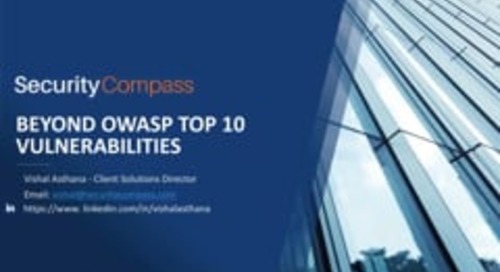The OWASP Top 10 is a solid starting point, but it omits critical vulnerabilities that remain prevalent and dangerous in modern web applications.
This webinar from Security Compass goes beyond the familiar OWASP list, exploring three impactful vulnerabilities—Race Conditions, HTTP Parameter Pollution (HPP), and Server-Side Request Forgery (SSRF)—that deserve equal attention in any security assessment strategy.
Why Is the OWASP Top 10 So Widely Used?
The OWASP Top 10 is popular because it’s concise, supported by tools, and often referenced in compliance standards.
Organizations adopt the OWASP Top 10 due to:
-
Simplicity: Only 10 categories make it accessible to development teams.
-
Tool Support: Most SAST/DAST tools report compliance against the Top 10.
-
Regulatory Relevance: Standards like PCI DSS cite the Top 10 as a reference point.
However, this widespread adoption often results in tunnel vision, leading teams to overlook other critical vulnerabilities that can pose equal or greater risk.
Why Look Beyond the OWASP Top 10?
Restricting security efforts to the OWASP Top 10 ignores many real-world vulnerabilities that adversaries actively exploit.
Even the latest OWASP list (e.g., 2017 or 2021) does not include threats like Race Conditions or SSRF. Organizations should treat OWASP as an entry-level checklist, not a complete solution.
What Is a Race Condition?
A race condition is a flaw that occurs when the timing of actions impacts system behavior, often leading to inconsistent or insecure outcomes.
| CWE ID | Description |
|---|---|
| 362 | Concurrent execution of threads leads to unpredictable states |
Exploit Example
A bug bounty researcher submitted multiple simultaneous payout requests, exploiting a timing issue. The server processed the transactions before marking the URL as invalid, resulting in multiple unauthorized Bitcoin payments.
How to Test for Race Conditions
-
Identify shared, unsynchronized data
-
Use tools like Race The Web or Burp Suite Intruder
-
Send concurrent requests and observe behavior anomalies
What Is HTTP Parameter Pollution (HPP)?
HPP occurs when multiple parameters with the same name but different values confuse backend logic, often leading to unexpected behavior.
| CWE ID | Description |
|---|---|
| 235 | Conflicting interpretation of input values |
Exploit Example
An attacker used a duplicate q= parameters with SQL fragments, crafting a single request that executed a SQL injection by manipulating how the backend parsed the inputs.
How to Test for HPP
-
Append identical parameters with varying values
-
Observe which value the server processes
-
Use Burp Suite to inspect requests across URL, body, and headers
Example Technologies & Behaviors
| Platform | Behavior with Duplicates |
|---|---|
| ASP.NET/IIS | Includes all parameter values |
| JSP/Servlets | Uses the first occurrence |
| Python | Parses as an array |
What Is Server-Side Request Forgery (SSRF)?
SSRF forces a server to make unauthorized requests, potentially reaching internal systems not accessible externally.
| CWE ID | Description |
|---|---|
| 918 | Server-side requests to internal resources |
Exploit Example
A researcher bypassed a filter that accepted image URLs by pointing it to an AWS metadata endpoint disguised as an image. The attacker extracted sensitive data by exploiting the server’s trust in internal addresses.
How to Test for SSRF
-
Change parameters to reference internal IPs (
127.0.0.1,169.254.169.254) -
Use Burp Collaborator to detect outbound requests
-
Test different ports and protocols to bypass filters
Key Differences Between These Vulnerabilities
| Vulnerability | Risk Impact | Common Vector | Test Tools |
|---|---|---|---|
| Race Condition | Timing abuse, data corruption | Concurrent requests | Race The Web, Burp |
| HTTP Parameter Pollution | Misrouted logic, injections | Duplicate parameters | Burp Suite Intruder |
| SSRF | Internal service exposure | URL inputs, open redirects | Burp Collaborator |
How Security Compass Can Help
Security Compass enables teams to go beyond surface-level compliance with tools, training, and services for secure development.
| Solution Area | Offering |
|---|---|
| Threat Modeling | SD Elements automates threat analysis and generates requirements |
| Security Training | 28 developer and tester courses, including OWASP Top 10 |
| Vulnerability Assessments | Manual + automated testing services via advisory team |
| DevSecOps Integration | Requirements flow directly into the developer’s ALM tools |
Final Thought: Make OWASP Your Starting Line, Not Your Finish Line
Effective application security goes beyond checklists—it requires proactive, contextual risk management.
While OWASP Top 10 remains a valuable awareness tool, threats like race conditions, HPP, and SSRF demonstrate that attackers don’t limit themselves to what’s popular. Teams must expand their testing and threat modeling scope to address real-world risks early and effectively.
